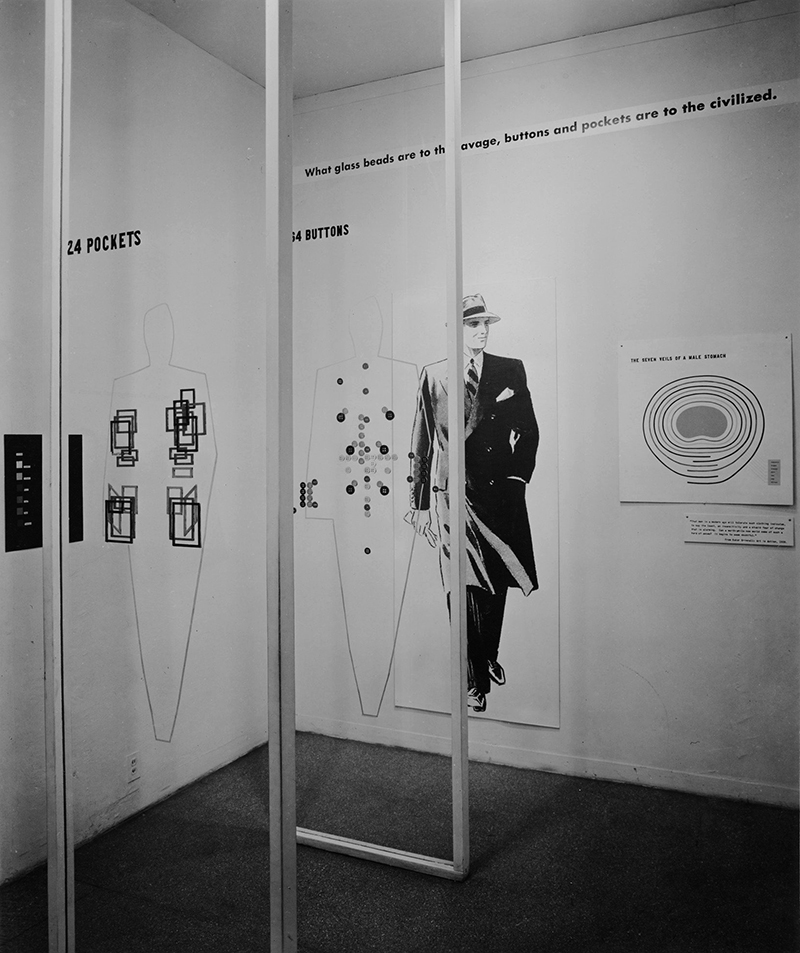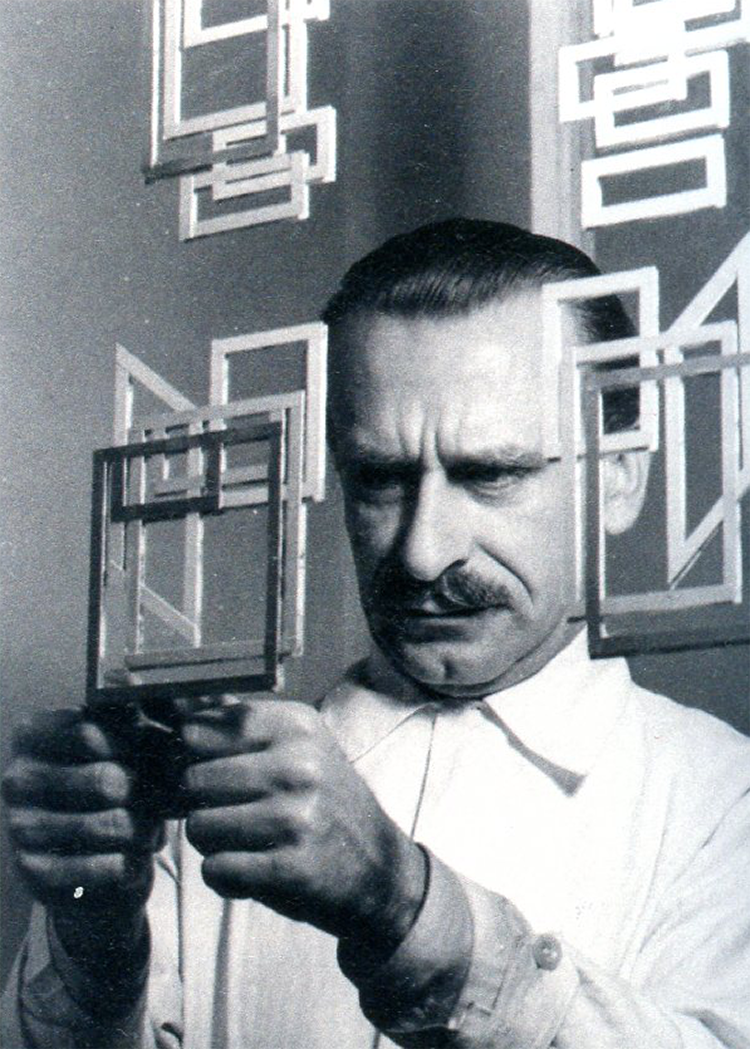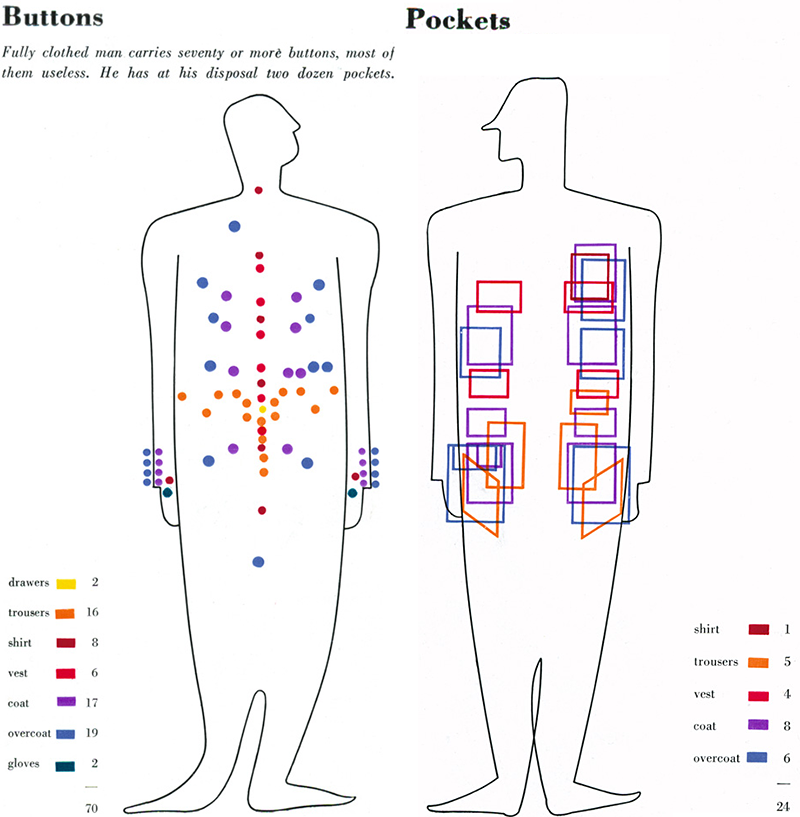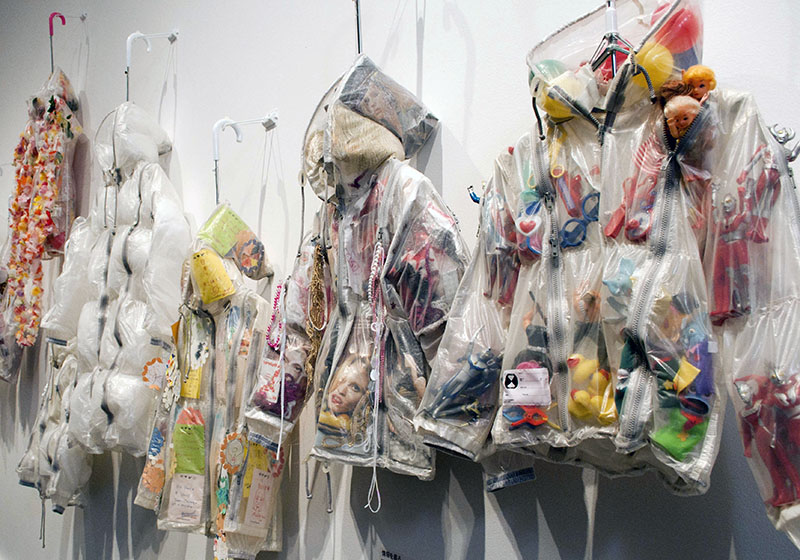
Bernard Rudofsky, installation view of “24 Pockets” and “78 Buttons,” November 28, 1944 – March 4, 1945, The Museum of Modern Art, New York.
This fall, the Museum of Modern Art will feature fashion for the second time in its history. Not since the architect and social critic Bernard Rudofsky curated “Are Clothes Modern?” in 1944 has the museum addressed the contribution of apparel to the design arts. Acknowledging that architecture and product design are commonly recognized as following functionalist precepts while fashion has been “looked down upon as ephemeral, decorative, and downright vacuous,” MoMA’s senior curator Paula Antonelli asserts that it is time to “recalibrate”—to bring fashion into the fold of a preeminent museum of art and design.
MoMA uses Rudofsky’s exhibition as a springboard for “Items: Is Fashion Modern?” and focuses, as Rudofsky did, on the histories, manufacture, and uses of specific articles and accessories of dress, rather than on notable designers. In paying an affectionate tribute to Rudofsky and loosely borrowing his methods and approach, MoMA makes a provocative choice—because nothing about mid-century dress pleased Rudofsky, the only director of MoMA’s short-lived Department of Apparel Research. Charged with being a harsh critic by the contemporary press and a disapproving scold by, apparently, his best friend, Rudofsky critiqued many aspects of fashion, including its “absurd” forms that hampered the body, its ability to signal gender and status distinctions, and the rapidity of fashion change and resulting expense and waste. “Are Clothes Modern?” was a passionate diatribe against fashion, in turns incisive and engaging, eccentric and obtuse, and, perhaps unsurprisingly, MoMA downplays much of Rudofsky’s larger agenda. Doing so, however, risks discounting the particular contours of Rudofsky’s claims. This fervent modernist so strongly believed that ephemeral fashion could be corralled and overruled by sense, reason, and the functionalist precepts of good design that he confidently questioned even the most unambiguously utilitarian aspect of dress: pockets. Those seemingly useful appendages, Rudofsky charged, only accommodated man’s stubborn beliefs in the protective, talismanic properties of the things he carries.
Rudofsky’s “24 Pockets” installation appeared in an exhibition focused on menswear, a challenging topic since men’s clothing had been long associated with sobriety and understatement. While Rudofsky pilloried “the follies” of women’s wear with dispatch, juxtaposing artifacts with striking formal similarities across varied cultures and historic periods (comparing “primitive” tattooing with “modern” makeup, for example), Rudofsky employed diagrams to deflate perceptions that the suit was a near-perfect form. Printed on the wall was a life-sized image of a man in business attire, perfectly outfitted—a Dick Tracy-like figure with a broad-shouldered build and conventional good looks of the 1940s. He wears a Fedora hat and handles gloves with élan; a pristine handkerchief peeks from a coat pocket. An exemplar of sleek urbanity, the figure strides forward confidently, only to be interrupted by two adjacent floor-to-ceiling glass panels. The first diagrammed the pockets in successive layers of the masculine suit, and the second, the number of buttons. As MoMA explained in its press release, Rudofsky had created a “simulated X-ray examination” of the standard masculine uniform, one that picked up on “calcified” components of dress that seemed to have spread at alarming rates.

Rudofsky installing “24 Pockets.” Illustration in “Free Feet: Architect designs new sandals to restore natural wiggle to toes,” Life (June 10, 1946), 83.
Pictured in Life magazine working on his installation while wearing the white lab coat of the scientist, Rudofsky frowns in concentration as he adjusts the rigid pocket-forms on his diagram. In keeping with the x-ray analogy, the diagram renders the soft, cloth pocket as preposterously rigid, as if “calcified.” If preposterous, Rudofsky’s x-ray faithfully demonstrated what we know about pockets: they come in pairs and singletons; they have different shapes and axial alignments; their placement shifts across the trunk with different articles of clothing; a preponderance congregates around chest and thighs and seem sensitive to handedness. Like any good object study, the installation compelled viewers to pause and reconsider a common thing and our relationship to it: what are we to make of our apparent fondness for pockets? Should we revise our picture of modern man, so seemingly self-possessed, if we acknowledge that he achieves his self-sufficiency with a panoply of concealed compartments—that the modern man is also a pocketed man?
Contemporary critics (the exhibition traveled the U.S. for two years), as well as later curators and scholars, have tended to interpret “24 Pockets” as a comic installation that reveals an endearing and harmless obsession suffered by men and their tailors. Considering “24 Pockets” in the context of “Are Clothes Modern?”, however, indicates that Rudofsky had more in mind than simply reforming men’s pocket mania by removing some of the offending excess; questioning pockets served as a stealth means to delegitimize an entire system of dress. Adjacent to “24 Pockets,” Rudofsky staged an unorthodox history of tailoring: on the wall hung chronologically arranged tailors’ patterns and adjustable dress-makers’ dummies and hat forms sat on raised platforms. From these seemingly innocuous tools of the trade, Rudofsky drew a sinister lesson: “Today’s designers don’t know any better way of using a fabric than cutting it to pieces.” Museum visitors seemed somewhat baffled by his conclusions; one reviewer for Newsweek wondered whether modern man should really be charged with “cruelty to fabrics.” Rudofsky expanded his polemic more fully in the 1947 book of the same title, explaining that the tailor stubbornly retained practices he had inherited from his “bronze age” forebears, who were “barbarians” and “invaders” that overtook classical civilization. These were hunters and nomads who pieced together irregularly shaped animal hides for protection, creating “skin-like” clothing consisting of cylinders, tubes and cones—making sleeves and trousers “ugly funnel-like excrescences,” according to Rudofsky. The skin-like articles represented a kind of “hollow casting” of its owner, he charged, and “hang like human effigies from the gallows of our clothes closets.”
Rudofsky’s visceral distaste for the tailored form extended to disdain for its maker. The tailor, Rudofsky contended, was less of a designer who thought anew about addressing problems than a tradition-bound “copyist.” Rather like a lazy house painter who adds a new layer of paint atop the old, the tailor insistently “covered up problems.” Rudofsky’s evidence? The “rampant…overgrowth” of pockets. Moving from the visual analogy of the x-ray in his installation to geological time and evolutionary frameworks in his book, Rudofsky likened the seven layers of clothing worn by the correctly dressed male to sedimentary layers of earthly matter, and he likened pockets to fossilized remains of living things—anything but modern. Rudofsky’s fanciful dress history suggested that the much celebrated suit was “the surviving expression” of long dead ideas.
While Rudofsky used pockets as proof that the suit was an “archaic” form, he also interrogated their design. Pockets no longer served a useful purpose, he claimed. Their proliferation meant that “sorting out,” “filling up” and “extracting” pocketed objects proved too tedious and maddening a business to consider; pocketed objects further ruined the fashionable silhouette, and no self-regarding man interested in his looks would be caught dead availing himself of them. The pocket-forms appearing in the “24 Pockets” installation and the revised illustration appearing his 1947 book were notably empty. Rudofsky seemed strangely unwilling to concede the importance of stuff (e.g.; keys, money and identification) to the person’s movements and negotiations. Pocketed objects were merely “ballast” or “cargo”—dead weight, undifferentiated goods, for which man had no specific use. Such things as handkerchiefs did not so much minister to a need, in Rudofsky’s view, as they were outdated emblems of “civility.”

78 buttons and 24 pockets illustrations by Rudofsky.
Rudofsky maintained his stubborn resistance to the idea that pocketed objects acted in critical ways to augment the self, even in the context of war, historically a period when temporary provisioning takes on urgency. Pockets have been most in evidence when people must “go forth carrying gas masks, numerous identification papers and ration cards,” as Life noted in a 1940 issue. Positioning Rudofsky’s 1944 show as part of its series meant to celebrate the contributions of design to the war effort, MoMA suggested that Rudofsky’s analyses would reveal “directions toward intelligent change now that…conventions of dress are undergoing modification because of the war.” Rudofsky suggested instead that the war effort depended in part on coercive kinds of making—that designers, in the case of fashion, relied on archaic forms like pockets to create solemn, militaristic dress. Pockets were “insignia of officiousness,” conferring not a bit of support. Pointing to the specifications for a woman’s uniform coat from the Quartermaster Corps, Rudofsky called out its “fake pockets.” “Every WAC and Wave’s uniform has two fake pockets over the breasts,” he complained. “War emergency did not inflict thoughtfulness on the maker of phony dress.” Pockets may look like a functional component of dress, but they only “symbolize efficiency,” he charged.
Rudofsky discounted the possibility that fake pockets offered the female WAC volunteer some measure of confidence through a projection of competence. It seemed outrageous that fashion could prefer the assertion of utility to utility itself. In hoping to neutralize the fear of going unprepared, fashion accommodates the person’s most pressing anxieties, making a fetish of both the pocketable objects he or she carried and the pockets—the containers—themselves. A statement printed on the wall above the figure underlined Rudofsky’s stance: “pockets and buttons are to the civilized as glass beads are to the savage.”
Pockets were notably absent in Rudofsky’s proposal for future dress. Next to images of the draped garments of classical antiquity, the chiton and peplos of ancient Greece, the exhibition featured contemporary designers who borrowed elements of draped construction while mass-producing their work—this reflected Rudofsky’s idea that this more rational dress system could be modernized to mitigate waste and decrease the labor required. “Clothing should be cloth itself,” he proclaimed. Rudofsky’s solution adhered to the progressive and democratic tenets of modernist designers: that high quality, simple dress that never went out of style could be available to all. Like Issey Miyake’s A-POC (“A Piece of Cloth”) project of the late 1990s in which Miyake produced a flexible knit tube that required no tailoring, Rudofsky proffered a universalizing, stable “answer” to the “problem” of clothing that worked outside the fashion system.

Kosuke Tsumura “Final Home multi-pocket coat”
“24 Pockets,” while witty and entertaining, thus also served as a prefatory salvo—a critique of western, tailored dress meant to lead a revolutionary, minimalist mode, and one that implicitly narrowed the capacity of apparel to act as a flexible interface between the person and the world. In the intervening decades, MoMA has recognized design’s (including apparel design’s) enlarged purview, noting that it is not merely concerned with aesthetics or functional instrumentality, but can be understood as a form of cultural practice that engages societal and cultural concerns of real import. Good design, while it must be efficient and reliable, can also provide psychological comfort or act as searching critique. Today, 24 pockets might not be enough, as the fashion designer Kosuke Tsumura demonstrates with his pointedly redundant “44 Pocket Coat,” which is included in MoMA’s 2006 exhibition, Safe: Design Takes on Risk. Arguing for clothing’s proactive, even defensive role in an uncertain world, Tsumura’s multi-pocketed coats act as mobile, wearable structures, directly addressing the person’s vulnerability in the face of societal and environmental threats. As Paula Antonelli observes in the exhibition catalog, “how safe we are depends on our perception of what is on hand to protect us.” Such perceptions may point to a degree of magical thinking, Rudofsky would be quick to assert, but fashion has been moving forward to meet them.
"Items: Is Fashion Modern?" opens at the Museum of Modern Art on October 1, 2017.
